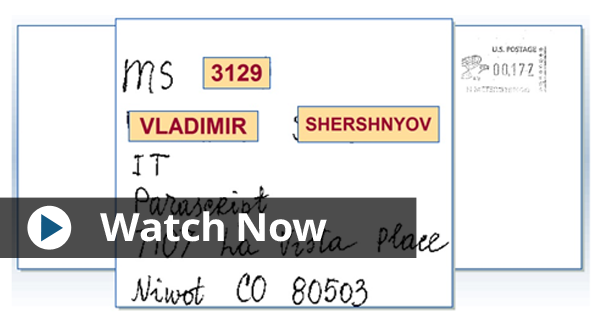For small companies and large enterprises alike, mail continues to be an integral part of the document workflow. In a typical mail center, 60 to 70 percent of the labor is spent sorting incoming and interoffice mail. Incoming mail is defined as those mail pieces that are received by any company, and in addition to the postal address, contain company-specific addressee information. Such information might include addressee name, title, department, subdivision, and other specific details. Unlike the postal address, this information is not regulated by strict rules, and it may appear in a great variety of formats on the mail piece. Enterprises are confronted with the problem of sorting, distributing, and processing incoming mail on a daily basis. These processes are laborious, expensive and time-consuming, and deal not just with letters and postcards, but with an increasing number of other formats including flats, accountable mail such as FedEx, UPS or USPS Express Mail, parcels, and faxes.
It is comparatively easy to manage the flow of incoming mail in small companies: often it is enough to read only the first and last name on an envelope to deliver the mail to the right person. However, the problem tends to grow with the size of a company and becomes a real challenge for large corporations.
The speed and accuracy in which mail is sorted and routed impacts overall business efficiency. It is difficult to find an industry or a company that can afford to ignore the importance of incoming mail processing. Efficient processing is particularly valuable in remittance/payment environments that deal with time-sensitive and/or valuable documents. A few examples include healthcare claims processing, accounts payable, accounts receivable and general insurance applications.
Depending on company size and correspondence volume, at least 2 to 2.5 percent of all mail is either misplaced or subjected to an in-house delivery delay, and can go as high as 3 percent for any company that has more than one site. These percentages may sound low, however, in terms of lost potential business they highlight a serious problem. For a company receiving up to 100 pieces of mail per day, about 600 are either delayed or misplaced annually. If just 10 percent of these mail pieces are customer-related, the company will miss 60 opportunities for potential revenue, contracts, payments, customer inquiries, and/or satisfaction.
The paradox is that even though organizations understand the importance of timely and accurate delivery of incoming mail, the processes of sorting and tracking are often still done manually, using the paper and clipboard method. This has been an area considered untouchable by automation, especially for small to medium-sized mail centers. The reason for this struggle lies in the specifics of the address block on the incoming mail pieces. While the structure of a postal address block is strictly defined, incoming mail structure is diverse and may diverge not only for different companies, but even within the same one. Therefore, it is difficult to find software that can reliably and efficiently process the entire spectrum of semi-structured addresses.
Nowadays there are products exploiting a new concept in reading incoming mail addresses. They are specifically designed to automatically recognize the wide variety of incoming mail and are intended to support high-volume mail processing facilities. Such products can sort any type of inbound company mail up to the depth required by the particular company. They are flexible, and can easily adapt to any address structure and field type defining the destination.
Click below to watch a quick video of incoming mail processing.




